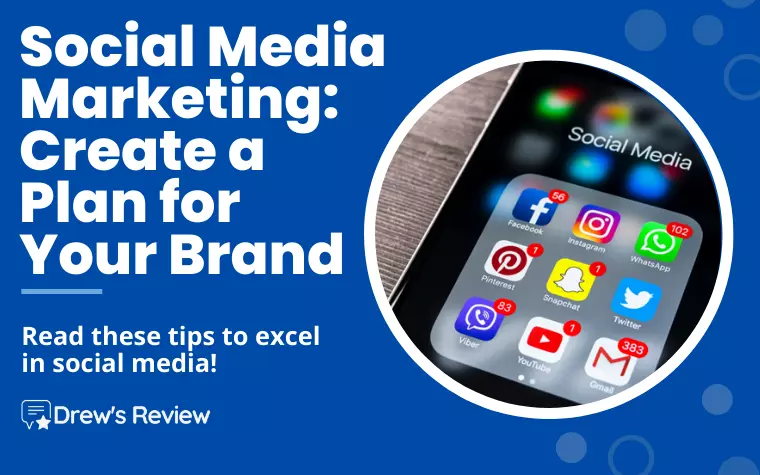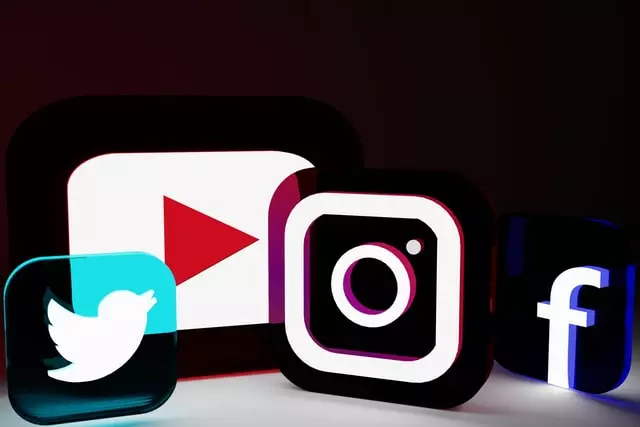
Almost every business has a social media presence these days. But not everyone is using social media marketing to its full potential.
If you're not sure where to start or you're making common mistakes, don't worry! In this article, we will walk you through everything you need to know about social media marketing.
I'll cover the basics of social media marketing, and I'll also give you some tips on how to create a successful social media plan for your brand.
What is Social Media Marketing?
Social media marketing is not only about blogging. It’s the process of using social media platforms to promote and sell your products or services. It can be used to build relationships with customers, create loyalty among customers, and drive sales.
When executed correctly, social media becomes a major growth channel for your business. But it’s important to remember that social media should support your broader marketing ecosystem—not replace it. A complete strategy also includes email marketing, paid ads, SEO, and content marketing.
You also need to have a well-rounded marketing strategy that includes other channels, such as email marketing, paid advertising, and content marketing.

Social Media Strategy: Importance for a Brand
Some business owners assume social media marketing is a distraction or a low-ROI activity. In reality, when done right, it can become one of the most cost-effective and impactful channels you have.
A well-built social media plan helps you strengthen customer relationships, build trust, and increase your brand’s visibility. It also helps you reach audiences you’d never find through traditional marketing.
By publishing engaging content and running targeted social media ads, you can reach people who are already interested in what you have to offer—and you can do it at a lower cost than most other advertising methods.
Why Social Media Matters for Brands
- You can reach a significantly larger audience with your marketing messages.
- You can build relationships with potential and existing customers.
- Customers can easily share feedback about your products or services.
- You can create a community around your brand.
- You can drive high-quality traffic to your website. Facebook in particular can be a powerful traffic source—here’s how to be successful with affiliate marketing on Facebook if you're using the platform to monetize your content.
These benefits apply whether you’re a one-person business or a large company.
How Social Media Algorithms Work in 2025
Understanding how algorithms prioritize content helps you create posts that consistently get traction.
Most platforms now prioritize:
- High watch time (especially video)
- Meaningful engagement (comments > likes)
- Saves and shares
- User intent signals (who stops scrolling to watch you)
- Post-to-profile relevance (content aligned with your niche)
Platforms like TikTok, Instagram Reels, and YouTube Shorts rely heavily on interest-based algorithms, meaning great content can still outperform big accounts. Your strategy should focus on value, relevance, and consistency rather than follower count alone.
Types of Social Media Content That Perform Best
To maximize reach, aim for a balanced mix of content formats:
Short-Form Video (Top Performer)
Videos under 30 seconds are dominating every platform.
Use them for tutorials, product showcases, storytelling, and quick educational posts.
Carousel Posts
Carousels consistently outperform single-image posts on Instagram and LinkedIn due to higher dwell time.
User-Generated Content (UGC)
Customer-created videos and photos build instant trust and outperform polished branded content.
Educational Micro-Posts
Quick tips, stats, or “one-sentence wisdom” posts perform extremely well on LinkedIn and X.
Community Engagement Posts
Polls, Q&As, “this or that” choices—these boost visibility across platforms.
2025 Social Media Trends Every Brand Should Know
AI-Assisted Content Creation
Brands now use AI tools for idea generation, content outlines, and captions—but still personalize everything for authenticity.
If you want to go deeper, see my guide on using AI to write articles to streamline your content creation process.
Short-Form Shopping
Instagram, TikTok Shop, and YouTube have streamlined in-video shopping.
Even small brands can now generate high ROI with product-tagged videos.
Rise of Nano & Micro Influencers
Influencers with 1k–50k followers deliver better engagement and lower cost than big creators, making them ideal for small businesses.
Community-Led Marketing
Brands are building private communities on Facebook Groups, Discord, and Instagram Broadcast Channels to nurture superfans.
Authenticity > Perfection
Raw, unedited content often performs better than heavily polished brand videos.
How to Measure Success: Key Social Media KPIs
Top-performing articles include KPI breakdowns, so here’s a compact section you can add:
Track these metrics to measure effectiveness:
- Reach & Impressions – how many people saw your content
- Engagement Rate – likes + comments + shares ÷ followers
- Click-Through Rate (CTR) – how many people clicked your links
- Conversion Rate – leads or sales generated
- Audience Growth Rate – how fast your followers are increasing
- Cost Per Result – critical for paid ads
Your KPIs should align directly with the goals you defined earlier in your plan.
Build a Social Media Content Calendar
A content calendar helps you stay consistent and strategic.
Include:
- Monthly themes
- Weekly post types
- Evergreen vs. trending posts
- Product launches or promos
- Engagement and live session dates
Pro Tip: Create a 3–5 content pillar system (e.g., tips, behind-the-scenes, customer stories, product showcases, memes). This simplifies planning and ensures variety.
Social Media Advertising Best Practices
High-ranking guides always have a paid ads section. Add this for completeness:
Start With Small, Data-Driven Tests
Run multiple small audiences or creatives simultaneously.
Scale only what works.
Use Retargeting Campaigns
Retarget people who visited your site, watched your videos, or engaged with your posts.
Create High-Intent Audiences
Examples:
- Website visitors in the last 30 days
- Engaged Instagram users
- TikTok viewers who watched 75%+
Use Lookalike Audiences
Platforms can clone your best customers for you, making your ad targeting significantly stronger.
Social Media Customer Service
More customers now ask questions—or complain—on social media before emailing support.
Make sure your brand:
- Responds quickly
- Uses a friendly, consistent tone
- Moves complex issues to private DM
- Resolves complaints publicly when appropriate (boosts trust)
Fast responses improve algorithmic ranking and customer loyalty.
Repurposing Content Across Platforms
To save time and improve ROI, repurpose one core idea across multiple formats:
Example:
1 long YouTube video →
3 short clips for TikTok/Reels/Shorts →
1 LinkedIn post →
1 carousel →
1 tweet thread →
1 blog section
This maximizes reach with minimal extra effort.
Competitor Analysis: What to Look For
Evaluate your competitors' social presence:
- Posting frequency
- Content formats
- Engagement rate
- Topics that perform best
- Their top-performing ads (use Facebook Ad Library)
- Their UGC strategy
- Their influencer partnerships
Competitor data helps you spot gaps and opportunities.
Social Media Tools Worth Considering (2025 Update)
Add a few more modern tools without altering your existing list:
- CapCut – short-form video creation
- Canva Pro – templates, captions, batch social graphics
- Notion – content calendar and team collaboration
- Metricool – analytics + cross-platform scheduling
- Later – visual planning + Instagram/TikTok scheduling
This list mirrors what top-ranking guides showcase.
Social Media Marketing for Small Businesses
A section competing articles often include. Short, simple, and authority-boosting:
Small businesses can win on social media even without big budgets. If you're building an online business with limited funds, my guide on how to start an online business when you're short on cash can help you get started the right way.
- Focus on 1–2 platforms, not all of them
- Prioritize authenticity over production value
- Share behind-the-scenes content
- Encourage customer reviews and UGC
- Use low-budget ad campaigns to test messaging
- Build a loyal community rather than chasing viral hits
Consistency always beats perfection.

Social Media Marketing Ideas and Tips
When it comes to social media techniques and practices, there are a lot of different ways that you can promote your brand on the market. But not all of them will be effective for every business, small or large. It's important to experiment and find what works best for you.
Here are a few ideas to get you started:
- Use social media ads. Social media advertising is a great way to reach new customers and grow your brand. If you're active on Facebook, you can also learn how to use Facebook for affiliate marketing to grow your audience even faster.. You can target specific demographics with your ads, and you can even use retargeting to reach people who have already shown an interest in your products or services.
- Collaborate with influencers. Influencer marketing is one of the most popular social media marketing strategies these days. And for good reason! Working with influencers can help you reach a new audience and improve your brand awareness.
- Create social media contests. Contests are a great way to engage your followers and grow your social media following. You can offer prizes for the best photos, the most creative videos, or even just for participation. Just make sure that you follow the rules of each social platform when you're running a contest.
Elements of a Social Media Marketing Plan
Now that we've covered some of the basics, let's talk about what goes into a social media marketing plan. A successful social media strategy should have the following elements:
- Goals. What do you want to achieve with your social media marketing? Do you want to increase brand effectiveness, drive traffic to your website, or generate leads?
- Target audience. Who are you trying to reach with your social media marketing? What are their demographics, interests, and needs?
- Platforms. Which social media platforms will you use to reach your target audience?
- Content. What kind of digital content will you share on social media? Will you post blog articles, photos, videos, or something else entirely? Consider using free video-making tools like Movavi Video Editor Plus, VSDC Video Editor, OpenShot, and DaVinci Resolve.
- Schedule. How often will you post on social media? What days and times will you post?
- Budget. How much money are you willing to spend on social media marketing campaigns?
Mistakes to Avoid
As with anything, there are mistakes that can be made when it comes to social media marketing. Here are a few examples of the most common mistakes:
- Not having a plan. As we mentioned before, it's important to have a social media marketing plan. Without one, it will be difficult to achieve your goal.
- Posting too much. It's great to be active on social media, but you don't want to overwhelm your followers with too much content. Stick to a schedule that you can manage and make sure that your content is high quality.
- Ignoring analytics. Social media platforms like YouTube have their own built-in analytics tools and templates. Use these tools to track your progress and see what's working well for you. Then, you can adjust your tactics accordingly.
- Not being responsive. If someone takes the time to leave a comment or ask a question, be sure to respond in a timely manner. Ignoring your followers will only lead to them losing interest in your brand.

Tools for Social Media Marketing
Hootsuite
Hootsuite is one of the essential tools here. It allows you to manage all of your social media accounts in one place. You can schedule posts, track who's talking about your brand, and measure your results.
Sprout Social
This tool also provides social media management features as well as powerful reporting tools.
BuzzSumo
This service helps you find the most popular content on social media so you can share it with your followers.
Google Analytics
GA can help you track the traffic you're getting from social media, and see how it's impacting your overall business goals.
Final Say
By following these tips, you can create social media marketing plans that will help you achieve your business goals.
Just remember to be strategic, set realistic goals, and measure your progress along the way. And don't forget to have some fun! Social media should be enjoyable for both you and your followers.
Enjoyed this article? Share it!
FAQs About Social Media Marketing
Adding FAQs improves topical completeness and helps target long-tail keywords.
1. How often should a business post on social media?
Most platforms reward posting 3–5 times per week, but quality always comes first.
2. What’s the best platform for beginners?
Instagram, TikTok, and Facebook are the easiest starting points for most brands.
3. Can social media marketing increase sales?
Yes—especially when combined with retargeting ads and strong calls-to-action.
4. Should you schedule posts or publish manually?
Scheduling ensures consistency, but real-time engagement still matters.
You Might Also Like:
- How to Sell an App: Your Complete Guide to a Profitable Mobile App Exit - November 19, 2025
- What Every Company Should Consider When Choosing Business Software - November 15, 2025
- Top Affiliate Marketing Trends to Watch in 2026 - November 12, 2025
